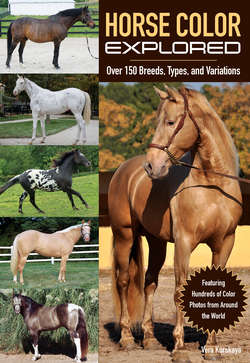Читать книгу Horse Economics - Vera Kurskaya - Страница 32
На сайте Литреса книга снята с продажи.
COLORS DETERMINED BY THE DUN GENE “Primitive” Markings
ОглавлениеThe color determined by the Dun gene (Dn+ allele) in combination with the bay base color is genetically close to the color of the ancestors of the domestic horse, as well as contemporary wild representatives of the species. They are also typical for aboriginal species. Including this group of colors in the category of dilutions is only relative: The main characteristic of the color dun is the presence of the so-called “Wild” or “primitive” markings. The dilution of hair is only an additional feature, and it is not present or obvious in all cases.
The following primitive markings are seen in horses with the Dun gene:
The dorsal stripe is a dark stripe that runs along the horse’s spine from the withers to the dock of the tail. Its main characteristic is clearly defined boundaries (Photos 26 & 27). It is possible to liken it to a wide line drawn on the horse with a fat-tipped marker. Sometimes you can also see short transverse stripes, which is called fishboning (or barbs) due to the similarity with a fish’s spine. Occasionally in horses with strong color dilution you can also find a zigzag-shaped or discontinuous dorsal stripe.
Zebra bars or zebra stripes are short, dark, transverse stripes on the horse’s legs, located in or above the region of the knees and hocks (Photo 28). Zebra bars are frequently present only on the backside of the legs.
Often on the backside of the lower part of the horse’s legs, you will see a line of lighter hair, known by some as a zipper (see Photo 109).
Cobwebbing or lacing is a net of dark lines, which converge in the center of forehead of some dun horses, resembling a cobweb. This marking rarely involves the eye area.
Many dun horses have dirty yellow, pale yellow, or even white strands of hair concentrated on the edges of the mane (Photo 29). Sometimes there can be so much frosting, as it is called, that the mane looks white. Although the latter scenario is rare, it can create difficulty in determining the color of the animal. Frosting is frequently dark in summer and becomes more noticeable in winter.
Frequently in addition to frosting in the mane, there is also light hair in the tail (light guard hair). It can be white or pale yellow and is located along the sides of the tail dock, concentrated at the base (see Photos 26 & 27).
Dark ear rims and white tips are present in almost all dun horses, spanning the perimeter of the ears (see Photo 29). In contrast to the bay and brown horses, this primitive marking is wider and has clearer boundaries.
When the lower part of the horse’s head, from the eyes to the nostrils, is darker than the forehead, neck, and body, he is said to have a mask (Photo 30). This is most noticeable when the horse is observed from a distance, and in bay- or black-based horses. It can be less obvious when the horse has white head markings.
Many horses have more or less noticeable darkening on the withers and shoulders in the form of a stripe or shadow (“wing”) perpendicular to the spine with poorly defined boundaries (Photo 31).
A noticeable concentration of dark hair is often found on the neck near the mane.
A ventral stripe along the horse’s underbelly resembles the dorsal stripe (see p. 22), but it runs down the middle of the abdomen parallel to the spine.
Of all the primitive markings described here, the dorsal stripe is the only one “required” for the categorization of dun color. Zebra bars on the legs are common, but they may not be always noticeable against dark background hair. The remaining markings I’ve mentioned are encountered in different combinations and can be poorly visible. The color of primitive markings varies and depends on the color of a particular horse. They are usually the color of the horse’s guard hair.
